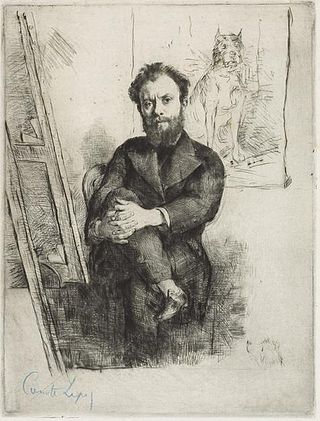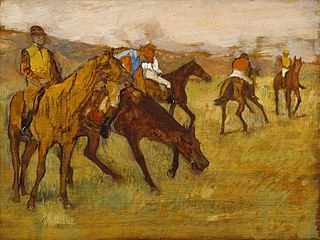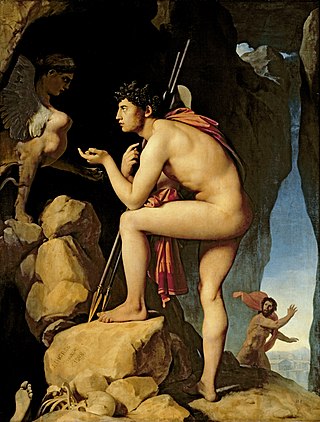
Berthe Marie Pauline Morisot was a French painter and a member of the circle of painters in Paris who became known as the Impressionists.

Mary Stevenson Cassatt was an American painter and printmaker. She was born in Allegheny, Pennsylvania, and lived much of her adult life in France, where she befriended Edgar Degas and exhibited with the Impressionists. Cassatt often created images of the social and private lives of women, with particular emphasis on the intimate bonds between mothers and children.

A pastel is an art medium that consist of powdered pigment and a binder. It can exist in a variety of forms, including a stick, a square, a pebble, and a pan of color, among other forms. The pigments used in pastels are similar to those used to produce some other colored visual arts media, such as oil paints; the binder is of a neutral hue and low saturation. The color effect of pastels is closer to the natural dry pigments than that of any other process.

The Musée d'Orsay is a museum in Paris, France, on the Left Bank of the Seine. It is housed in the former Gare d'Orsay, a Beaux-Arts railway station built between 1898 and 1900. The museum holds mainly French art dating from 1848 to 1914, including paintings, sculptures, furniture, and photography. It houses the largest collection of Impressionist and post-Impressionist masterpieces in the world, by painters including Berthe Morisot, Claude Monet, Édouard Manet, Degas, Renoir, Cézanne, Seurat, Sisley, Gauguin, and van Gogh. Many of these works were held at the Galerie nationale du Jeu de Paume prior to the museum's opening in 1986. It is one of the largest art museums in Europe.

Edgar Degas was a French Impressionist artist famous for his pastel drawings and oil paintings.

Portraits at the Stock Exchange is a painting by the French artist Edgar Degas. Completed in about 1879, the painting was already in the collection of the French banker Ernest May when it was listed in the catalogue of the fourth Impressionist exhibition that year. It may also have been shown in the next Impressionist exhibit in 1880, but it was not well known until it entered the collections of the Louvre in 1923. The canvas shows an interior corner of the open trading floor of the Paris Stock Exchange. May stands in the center of the picture wearing a top hat and pince-nez, listening to his colleague, a certain M. Bolâtre, leaning over his shoulder. They are likely discussing a document, possibly a bordereau, held aloft by a partially obscured third party.

The Child's Bath is an 1893 oil painting by American artist Mary Cassatt. The painting continues her interest in depicting bathing and motherhood, but it is distinct in its angle of vision. Both the subject matter and the overhead perspective were inspired by Japanese Woodcut prints and Edgar Degas.

The Cirque Medrano is a French circus that was located at 63 Boulevard de Rochechouart, at the corner of rue des Martyrs, in the 18th arrondissement at the edge of Montmartre in Paris. It was originally called Cirque Fernando. The title "Cirque Medrano" is still active today: it is now a successful French traveling circus.

The Bellelli Family, also known as Family Portrait, is an oil painting on canvas by Edgar Degas (1834–1917), painted c. 1858–1867, and housed in the Musée d'Orsay. A masterwork of Degas' youth, the painting is a portrait of his aunt, her husband, and their two young daughters.

Ludovic-Napoléon Lepic was a French artist, archaeologist and patron of the arts. He was styled as Vicomte Lepic until his father's death in 1875, when he succeeded to the title of Comte Lepic. He is best remembered today as a friend of Edgar Degas, who included him in some eleven paintings and pastels. He was among the original Impressionist group and later became a recognised marine painter.

The Dance Lesson is an oil on canvas painting by the French artist Edgar Degas created around 1879. It is currently kept at the National Gallery of Art in Washington, D.C. There is at least one other work by Degas by this title, also made in about 1879, which is a pastel.

Before the Race (1882–1884) is a painting by Impressionist painter, Edgar Degas, who began painting scenes with horses in the 1860s.

Little Girl in a Blue Armchair is an 1878 oil painting by the American painter, printmaker, pastelist, and connoisseur Mary Cassatt. It is in the collection of the National Gallery of Art, Washington D.C. Edgar Degas made some changes in the painting.

After the Bath, Woman Drying Herself is a pastel drawing by Edgar Degas, made between 1890 and 1895. Since 1959, it has been in the collection of the National Gallery, London. This work is one in a series of pastels and oils that Degas created depicting female nudes. Originally, Degas exhibited his works at Impressionist exhibitions in Paris, where he gained a loyal following.

The Circus is an oil on canvas painting by Georges Seurat. It was his last painting, made in a Neo-Impressionist style in 1890–91, and remained unfinished at his death in March 1891. The painting is located at the Musée d'Orsay in Paris.

Oedipus and the Sphinx is a painting by the French Neoclassical artist Jean-Auguste-Dominique Ingres. Originally a student work painted in 1808, it was enlarged and completed in 1827. The painting depicts Oedipus explaining the riddle of the Sphinx. An oil painting on canvas, it measures 189 x 144 cm, and is in the Louvre, which acquired it in 1878.

Miss La La was an expert aerialist who served as muse to Edgar Degas and was depicted in his 1879 painting Miss La La at the Cirque Fernando. She was also depicted in a poster for the Folies Bergère. She was the star of Troupe Kaira, a traveling circus act, and performed with the Cirque Fernando, based in Montmartre.
Girl Arranging Her Hair is an 1886 painting by American artist Mary Cassatt. The painting currently is in the collection of the National Gallery of Art, in Washington, D.C. It was originally exhibited at the Eighth and last Impressionist exhibition, which opened on May 15, 1886.
Ukrainian Dancers is a theme series of pastels by Edgar Degas depicting Ukrainian women performing folk dances. Degas created these drawings during the 1890s and early 1900s.

Lorenzo Pagans and Auguste de Gas is the title of a painting by Edgar Degas. Painted in oil on canvas, it is 54.5 cm high and 39.5 cm wide. The double portrait, painted around 1871–1872, shows the Catalan tenor Lorenzo Pagans performing a song and guitar recital. The painter's father, Auguste de Gas, sits in the audience behind him. The painting is one of a series of portraits of musicians that Degas painted beginning in the late 1860s. It is in the collection of the Musée d'Orsay in Paris.






















